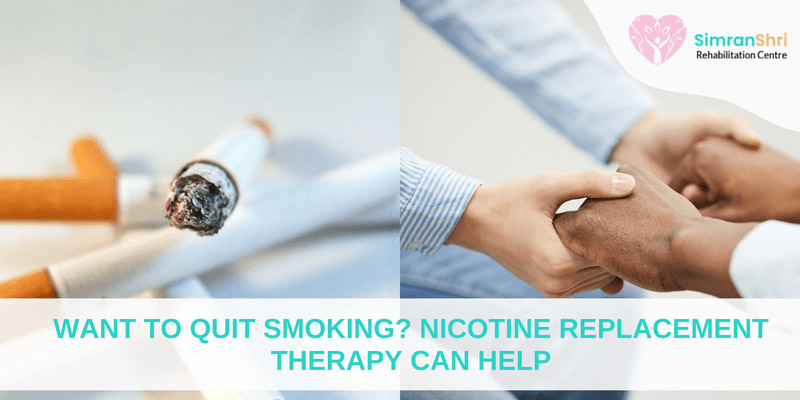

In today's time, it is beyond the realms of possibility to be unaware of the risks associated with smoking cigarettes or tobacco consumption. Every tobacco user is well-versed with the risks of cancer, heart ailments, stroke, and many other issues. Yet quitting smoking doesn't come easy to individuals.
Irrespective of one's consumption, whether smoking a cigarette post-work or lighting one with friends, a single puff introduces the body to nicotine. This initiates the problem; nicotine gives rise to cravings despite you being aware of the reasons not to smoke. Most people who develop an addiction to nicotine have reported that they feel- "stressed", "require it during socialising", or "cannot function without smoking". These complaints indicate nicotine addiction, and as soon as one abstains from nicotine use, they experience unpleasant withdrawal symptoms such as anger, irritability, hunger, insomnia, and untrollable cravings.
Dive in to find out how nicotine replacement therapy works and how one can yield the most out of it.

The main reason stated by individuals to not quit tobacco is the unpleasant withdrawal symptoms and the untrollable cravings. Nicotine replacement therapy helps with reducing these symptoms.
Many individuals are successful in quitting tobacco without the assistance of nicotine replacement therapy, yet many fail on their first try. The majority of individuals require multiple attempts before they succeed in quitting tobacco. They tend to get back to smoking during the first month as soon as they experience unpleasant withdrawal symptoms.
Fortunately, individuals do succeed in quitting tobacco, and the number of people who have given up smoking is more than the number of people that currently smoke. A tobacco dependence program, including counselling and nicotine replacement therapy, helps increase the number of individuals that have quit smoking.
One can begin using nicotine replacement therapy as soon as one abstains from tobacco use. No specific time is required to start using the patch, lozenge, gum, inhaler or nasal spray. Cross-check with the information on the chosen form of nicotine replacement, but generally, nicotine replacement therapy does not need time to wait.
There is no single or combined form of nicotine replacement therapy clinically proven to be the best. When choosing a nicotine replacement therapy, one should consider the method that best suits their lifestyle, smoking pattern, or smokeless tobacco. For instance, does one need to chew continuously or keep their hands busy? Is one searching for a once-a-day convenience? How frequent or controllable are the nicotine cravings?
Here is how one can choose the best nicotine replacement therapy for themselves:
● Nicotine gums, inhalers, and lozenges are used as substitutes that keep the mouth engaged such that the cravings are in control.
● Lozenges and nicotine gums are usually sugar-free but check with a professional if you have diabetes.
● Nicotine nasal spray works instantly and comes in handy when most needed.
● Nicotine inhalers work as pseudo cigarettes, i.e., one can puff and hold the inhaler sans the ill effects of cigarettes.
● Nicotine patches are a one-a-day convenience, as it just needs to be put on once a day.
● Nasal sprays and inhalers need a prescription for doctors.
● It is not advisable for individuals struggling with allergies or other conditions to use nasal sprays, inhalers, or patches.
● Nicotine gum might stick to dental work or dentures, making it hard to chew.
Regardless of the type you choose, follow the recommended nicotine replacement therapy dosage. It is not advisable to use this therapy in the long run, but if used for relapse prevention, continuous use is preferred over falling back to tobacco.
Using a different dosage or stopping use before time makes nicotine replacement therapy ineffective. The Best Tobacco Addiction Treatment helps set a suitable dose for individuals who wish to manage cravings through nicotine replacement therapy.
Researchers suggest that various commercially available forms of nicotine replacement therapy (transdermal patches, gum, inhalers, nasal spray, lozenges/sublingual tablets) increase the chances of successfully quitting smoking. Nicotine replacement therapy increases the rate of quitting by 50 to 70% (Stead et al., 2008).
Nicotine replacement therapy deals with physical dependence. It is not the go-to solution for quitting tobacco. One needs to deal with addiction's mental and emotional aspects to quit smoking or tobacco successfully.
Research shows that combining nicotine replacement therapy with a tobacco cessation program helps change one's behaviour and improves the chances of quitting and maintaining recovery compared to depending on a single method for quitting.
The ideal time to begin nicotine replacement therapy is when one first quits tobacco. Individuals often attempt quitting tobacco themselves and begin nicotine replacement therapy within a day. This does not yield the desired chances of success, but do not let it deviate from your goal. There are plenty of options available to help you quit tobacco and maintain recovery. Just remember that quitting tobacco or any other addiction is never achieved overnight.
It is advisable to use nicotine replacement therapy for a limited time frame. The dosage should be gradually tapered down before stopping. Studies to date do not show the benefits of long term nicotine replacement therapy impacting successful quitting. However, long-term nicotine replacement therapy is chosen over smoking.
Research is still being conducted to refine nicotine replacement therapy usage. If one feels that they require the therapy for a longer time than recommended, it is best to discuss this with a mental health professional.
Nicotine replacement therapy has the potential of causing dependence. Nicotine is highly addictive, and individuals might transfer their addiction from tobacco to nicotine replacement therapy.
If you or your loved ones are struggling with tobacco addiction or cannot stop nicotine replacement therapy, contact our mental health professionals today.
Tags: best nicotine replacement therapy, how nicotine replacement therapy works, Nicotine Replacement Therapy, nicotine replacement therapy success rate